The Role of Amygdala Dysfunction in Criminal Justice and Violence
VerifiedAdded on 2023/04/11
|6
|934
|262
Essay
AI Summary
This essay investigates the correlation between amygdala dysfunction and violent behavior. It explores how the amygdala, a key component of the limbic system, influences emotional processing and decision-making, potentially leading to aggressive responses. The paper analyzes studies that highlight the increased amygdala activity in violent offenders, linking it to difficulties in emotional regulation and impulse control. The essay also examines contrasting viewpoints, such as the attenuated aggression in psychopathic individuals with amygdala dysfunction. Furthermore, it delves into the interplay between the amygdala and the prefrontal cortex in the context of violence, particularly in adolescents. The conclusion emphasizes the critical role of amygdala function in shaping emotional responses and its implications for understanding and addressing violent tendencies within the criminal justice system. The essay references multiple studies to support its arguments.
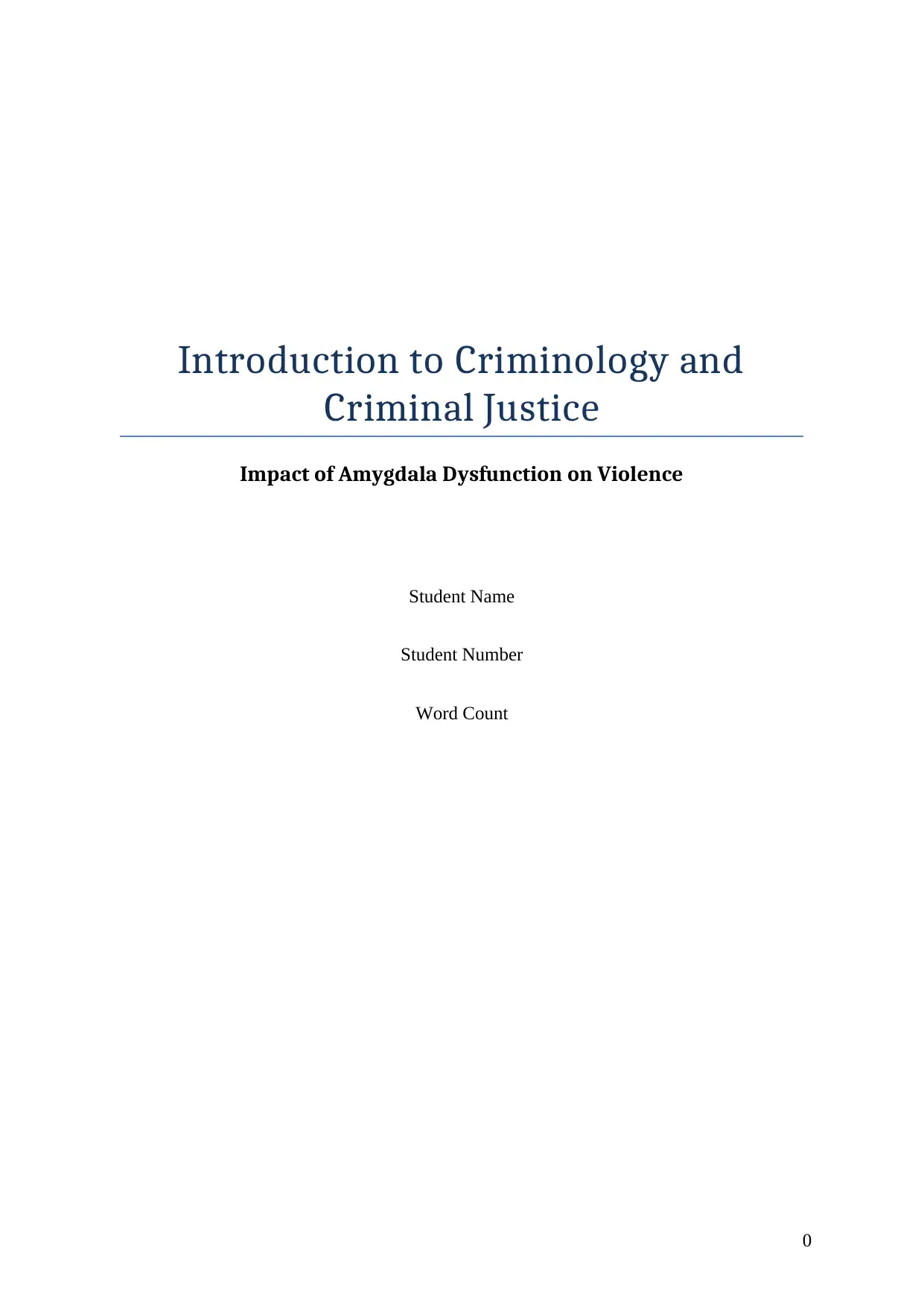
Introduction to Criminology and
Criminal Justice
Impact of Amygdala Dysfunction on Violence
Student Name
Student Number
Word Count
0
Criminal Justice
Impact of Amygdala Dysfunction on Violence
Student Name
Student Number
Word Count
0
Paraphrase This Document
Need a fresh take? Get an instant paraphrase of this document with our AI Paraphraser

Abstract
The aim of this paper is to evaluate the impact of amygdala dysfunction on violence
by evaluating a wide range of literatures. This paper will understand how amygdala
dysfunction encourages people to engage in violent activities rather than thinking rationally
which increases their chance of aggressively reacting to a situation. This paper will evaluate
critics that provide a contrary view and justify the arguments based on the support of studies
on this topic.
The aim of this paper is to evaluate the impact of amygdala dysfunction on violence
by evaluating a wide range of literatures. This paper will understand how amygdala
dysfunction encourages people to engage in violent activities rather than thinking rationally
which increases their chance of aggressively reacting to a situation. This paper will evaluate
critics that provide a contrary view and justify the arguments based on the support of studies
on this topic.
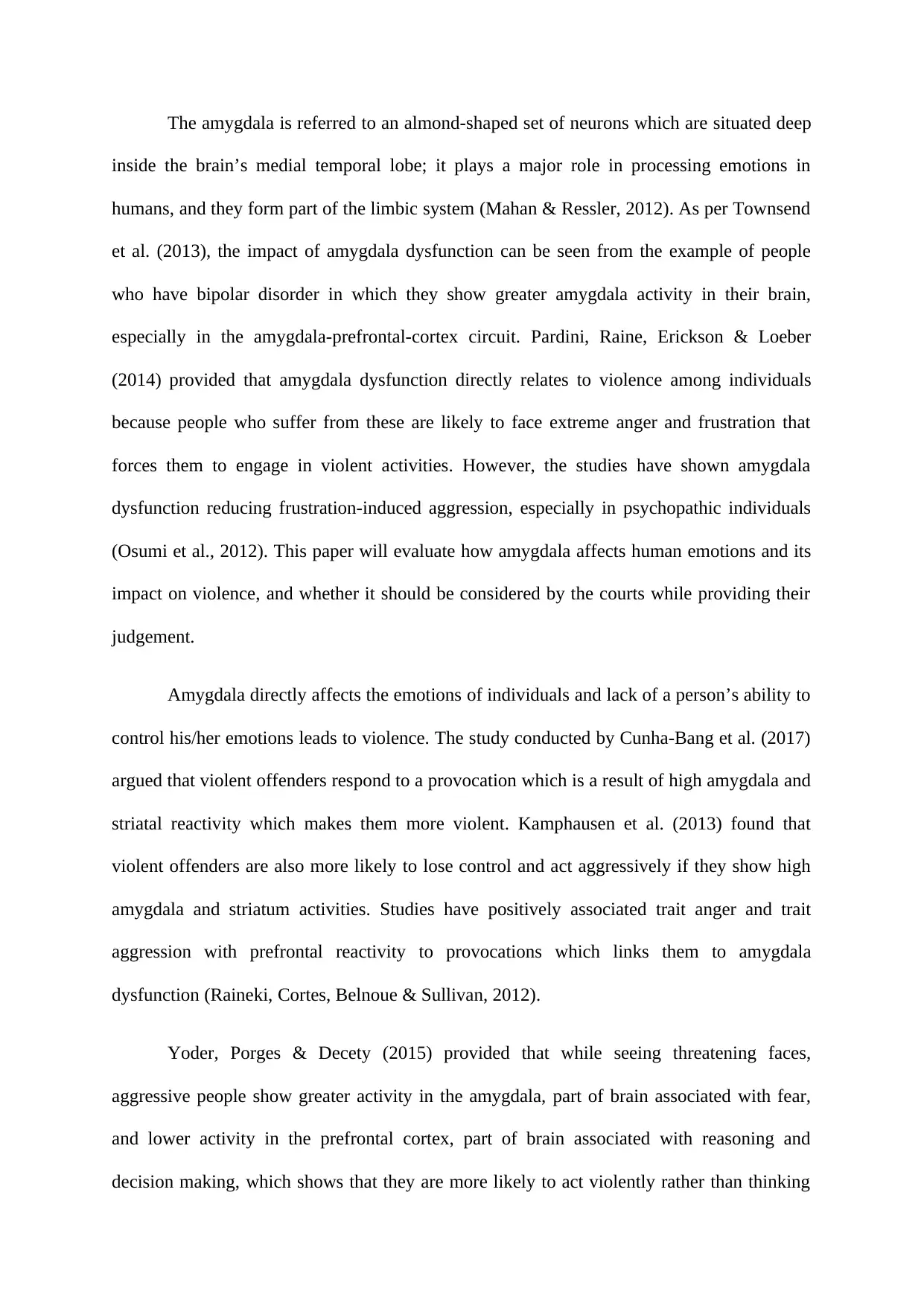
The amygdala is referred to an almond-shaped set of neurons which are situated deep
inside the brain’s medial temporal lobe; it plays a major role in processing emotions in
humans, and they form part of the limbic system (Mahan & Ressler, 2012). As per Townsend
et al. (2013), the impact of amygdala dysfunction can be seen from the example of people
who have bipolar disorder in which they show greater amygdala activity in their brain,
especially in the amygdala-prefrontal-cortex circuit. Pardini, Raine, Erickson & Loeber
(2014) provided that amygdala dysfunction directly relates to violence among individuals
because people who suffer from these are likely to face extreme anger and frustration that
forces them to engage in violent activities. However, the studies have shown amygdala
dysfunction reducing frustration-induced aggression, especially in psychopathic individuals
(Osumi et al., 2012). This paper will evaluate how amygdala affects human emotions and its
impact on violence, and whether it should be considered by the courts while providing their
judgement.
Amygdala directly affects the emotions of individuals and lack of a person’s ability to
control his/her emotions leads to violence. The study conducted by Cunha-Bang et al. (2017)
argued that violent offenders respond to a provocation which is a result of high amygdala and
striatal reactivity which makes them more violent. Kamphausen et al. (2013) found that
violent offenders are also more likely to lose control and act aggressively if they show high
amygdala and striatum activities. Studies have positively associated trait anger and trait
aggression with prefrontal reactivity to provocations which links them to amygdala
dysfunction (Raineki, Cortes, Belnoue & Sullivan, 2012).
Yoder, Porges & Decety (2015) provided that while seeing threatening faces,
aggressive people show greater activity in the amygdala, part of brain associated with fear,
and lower activity in the prefrontal cortex, part of brain associated with reasoning and
decision making, which shows that they are more likely to act violently rather than thinking
inside the brain’s medial temporal lobe; it plays a major role in processing emotions in
humans, and they form part of the limbic system (Mahan & Ressler, 2012). As per Townsend
et al. (2013), the impact of amygdala dysfunction can be seen from the example of people
who have bipolar disorder in which they show greater amygdala activity in their brain,
especially in the amygdala-prefrontal-cortex circuit. Pardini, Raine, Erickson & Loeber
(2014) provided that amygdala dysfunction directly relates to violence among individuals
because people who suffer from these are likely to face extreme anger and frustration that
forces them to engage in violent activities. However, the studies have shown amygdala
dysfunction reducing frustration-induced aggression, especially in psychopathic individuals
(Osumi et al., 2012). This paper will evaluate how amygdala affects human emotions and its
impact on violence, and whether it should be considered by the courts while providing their
judgement.
Amygdala directly affects the emotions of individuals and lack of a person’s ability to
control his/her emotions leads to violence. The study conducted by Cunha-Bang et al. (2017)
argued that violent offenders respond to a provocation which is a result of high amygdala and
striatal reactivity which makes them more violent. Kamphausen et al. (2013) found that
violent offenders are also more likely to lose control and act aggressively if they show high
amygdala and striatum activities. Studies have positively associated trait anger and trait
aggression with prefrontal reactivity to provocations which links them to amygdala
dysfunction (Raineki, Cortes, Belnoue & Sullivan, 2012).
Yoder, Porges & Decety (2015) provided that while seeing threatening faces,
aggressive people show greater activity in the amygdala, part of brain associated with fear,
and lower activity in the prefrontal cortex, part of brain associated with reasoning and
decision making, which shows that they are more likely to act violently rather than thinking
⊘ This is a preview!⊘
Do you want full access?
Subscribe today to unlock all pages.

Trusted by 1+ million students worldwide
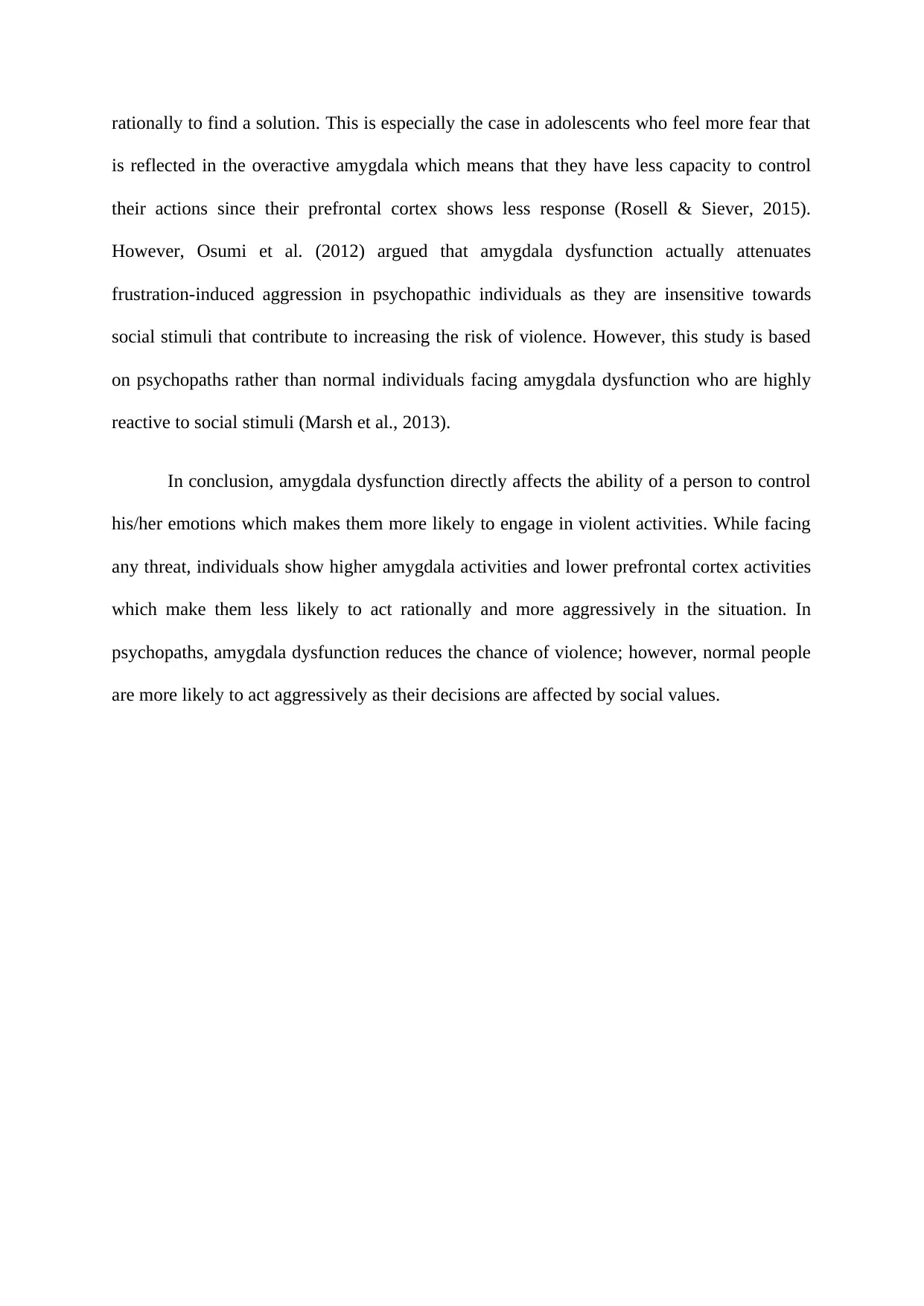
rationally to find a solution. This is especially the case in adolescents who feel more fear that
is reflected in the overactive amygdala which means that they have less capacity to control
their actions since their prefrontal cortex shows less response (Rosell & Siever, 2015).
However, Osumi et al. (2012) argued that amygdala dysfunction actually attenuates
frustration-induced aggression in psychopathic individuals as they are insensitive towards
social stimuli that contribute to increasing the risk of violence. However, this study is based
on psychopaths rather than normal individuals facing amygdala dysfunction who are highly
reactive to social stimuli (Marsh et al., 2013).
In conclusion, amygdala dysfunction directly affects the ability of a person to control
his/her emotions which makes them more likely to engage in violent activities. While facing
any threat, individuals show higher amygdala activities and lower prefrontal cortex activities
which make them less likely to act rationally and more aggressively in the situation. In
psychopaths, amygdala dysfunction reduces the chance of violence; however, normal people
are more likely to act aggressively as their decisions are affected by social values.
is reflected in the overactive amygdala which means that they have less capacity to control
their actions since their prefrontal cortex shows less response (Rosell & Siever, 2015).
However, Osumi et al. (2012) argued that amygdala dysfunction actually attenuates
frustration-induced aggression in psychopathic individuals as they are insensitive towards
social stimuli that contribute to increasing the risk of violence. However, this study is based
on psychopaths rather than normal individuals facing amygdala dysfunction who are highly
reactive to social stimuli (Marsh et al., 2013).
In conclusion, amygdala dysfunction directly affects the ability of a person to control
his/her emotions which makes them more likely to engage in violent activities. While facing
any threat, individuals show higher amygdala activities and lower prefrontal cortex activities
which make them less likely to act rationally and more aggressively in the situation. In
psychopaths, amygdala dysfunction reduces the chance of violence; however, normal people
are more likely to act aggressively as their decisions are affected by social values.
Paraphrase This Document
Need a fresh take? Get an instant paraphrase of this document with our AI Paraphraser
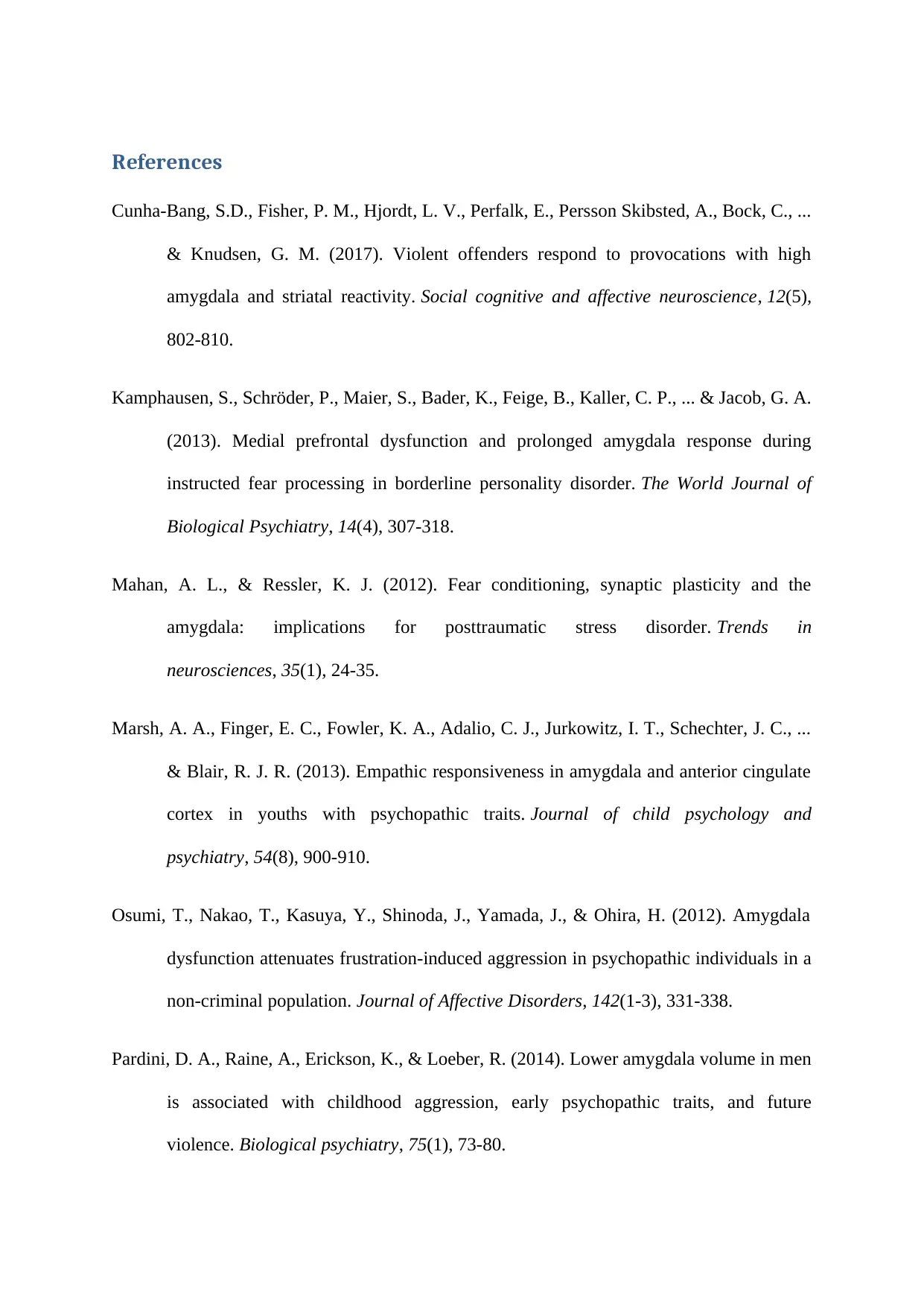
References
Cunha-Bang, S.D., Fisher, P. M., Hjordt, L. V., Perfalk, E., Persson Skibsted, A., Bock, C., ...
& Knudsen, G. M. (2017). Violent offenders respond to provocations with high
amygdala and striatal reactivity. Social cognitive and affective neuroscience, 12(5),
802-810.
Kamphausen, S., Schröder, P., Maier, S., Bader, K., Feige, B., Kaller, C. P., ... & Jacob, G. A.
(2013). Medial prefrontal dysfunction and prolonged amygdala response during
instructed fear processing in borderline personality disorder. The World Journal of
Biological Psychiatry, 14(4), 307-318.
Mahan, A. L., & Ressler, K. J. (2012). Fear conditioning, synaptic plasticity and the
amygdala: implications for posttraumatic stress disorder. Trends in
neurosciences, 35(1), 24-35.
Marsh, A. A., Finger, E. C., Fowler, K. A., Adalio, C. J., Jurkowitz, I. T., Schechter, J. C., ...
& Blair, R. J. R. (2013). Empathic responsiveness in amygdala and anterior cingulate
cortex in youths with psychopathic traits. Journal of child psychology and
psychiatry, 54(8), 900-910.
Osumi, T., Nakao, T., Kasuya, Y., Shinoda, J., Yamada, J., & Ohira, H. (2012). Amygdala
dysfunction attenuates frustration-induced aggression in psychopathic individuals in a
non-criminal population. Journal of Affective Disorders, 142(1-3), 331-338.
Pardini, D. A., Raine, A., Erickson, K., & Loeber, R. (2014). Lower amygdala volume in men
is associated with childhood aggression, early psychopathic traits, and future
violence. Biological psychiatry, 75(1), 73-80.
Cunha-Bang, S.D., Fisher, P. M., Hjordt, L. V., Perfalk, E., Persson Skibsted, A., Bock, C., ...
& Knudsen, G. M. (2017). Violent offenders respond to provocations with high
amygdala and striatal reactivity. Social cognitive and affective neuroscience, 12(5),
802-810.
Kamphausen, S., Schröder, P., Maier, S., Bader, K., Feige, B., Kaller, C. P., ... & Jacob, G. A.
(2013). Medial prefrontal dysfunction and prolonged amygdala response during
instructed fear processing in borderline personality disorder. The World Journal of
Biological Psychiatry, 14(4), 307-318.
Mahan, A. L., & Ressler, K. J. (2012). Fear conditioning, synaptic plasticity and the
amygdala: implications for posttraumatic stress disorder. Trends in
neurosciences, 35(1), 24-35.
Marsh, A. A., Finger, E. C., Fowler, K. A., Adalio, C. J., Jurkowitz, I. T., Schechter, J. C., ...
& Blair, R. J. R. (2013). Empathic responsiveness in amygdala and anterior cingulate
cortex in youths with psychopathic traits. Journal of child psychology and
psychiatry, 54(8), 900-910.
Osumi, T., Nakao, T., Kasuya, Y., Shinoda, J., Yamada, J., & Ohira, H. (2012). Amygdala
dysfunction attenuates frustration-induced aggression in psychopathic individuals in a
non-criminal population. Journal of Affective Disorders, 142(1-3), 331-338.
Pardini, D. A., Raine, A., Erickson, K., & Loeber, R. (2014). Lower amygdala volume in men
is associated with childhood aggression, early psychopathic traits, and future
violence. Biological psychiatry, 75(1), 73-80.
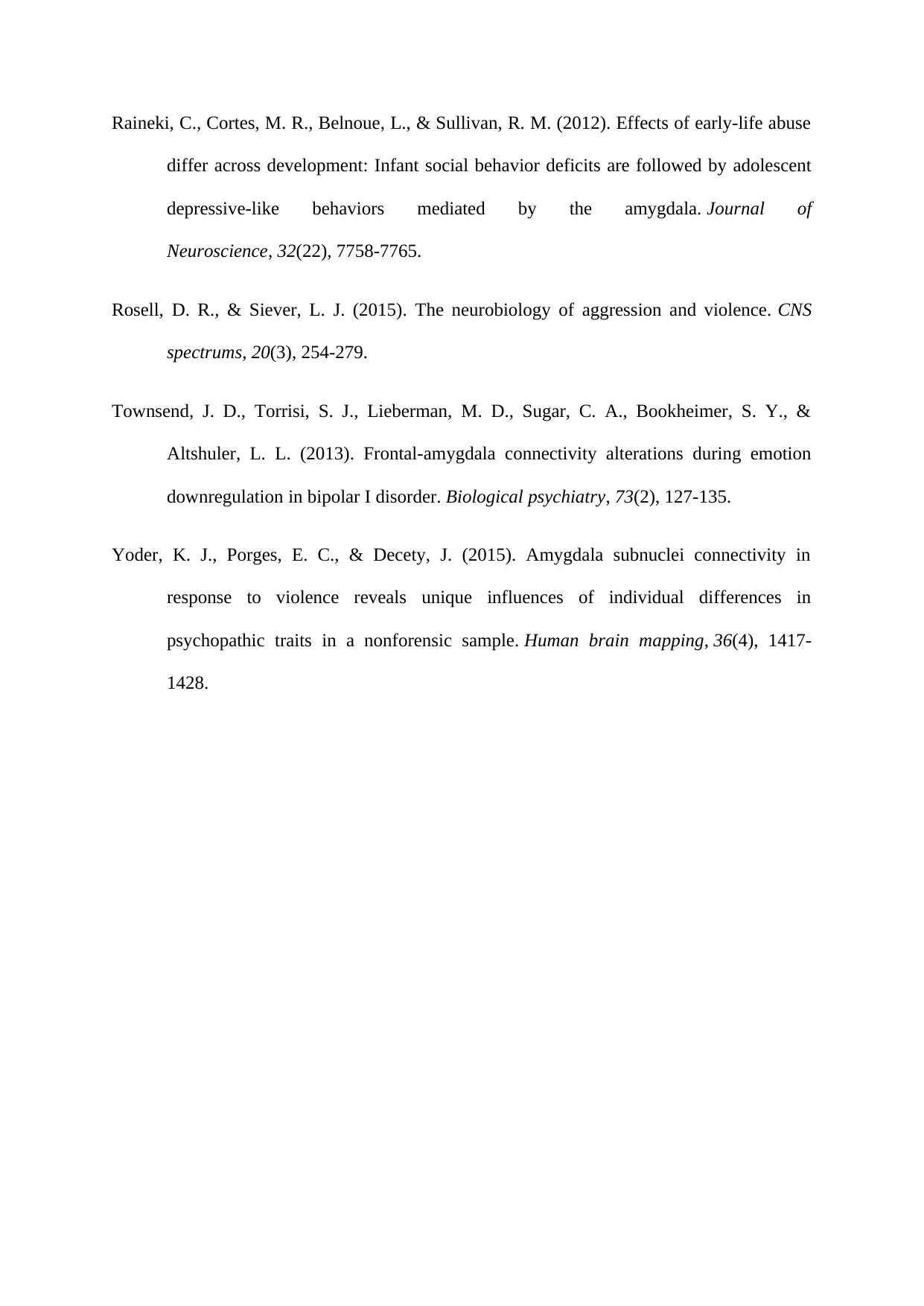
Raineki, C., Cortes, M. R., Belnoue, L., & Sullivan, R. M. (2012). Effects of early-life abuse
differ across development: Infant social behavior deficits are followed by adolescent
depressive-like behaviors mediated by the amygdala. Journal of
Neuroscience, 32(22), 7758-7765.
Rosell, D. R., & Siever, L. J. (2015). The neurobiology of aggression and violence. CNS
spectrums, 20(3), 254-279.
Townsend, J. D., Torrisi, S. J., Lieberman, M. D., Sugar, C. A., Bookheimer, S. Y., &
Altshuler, L. L. (2013). Frontal-amygdala connectivity alterations during emotion
downregulation in bipolar I disorder. Biological psychiatry, 73(2), 127-135.
Yoder, K. J., Porges, E. C., & Decety, J. (2015). Amygdala subnuclei connectivity in
response to violence reveals unique influences of individual differences in
psychopathic traits in a nonforensic sample. Human brain mapping, 36(4), 1417-
1428.
differ across development: Infant social behavior deficits are followed by adolescent
depressive-like behaviors mediated by the amygdala. Journal of
Neuroscience, 32(22), 7758-7765.
Rosell, D. R., & Siever, L. J. (2015). The neurobiology of aggression and violence. CNS
spectrums, 20(3), 254-279.
Townsend, J. D., Torrisi, S. J., Lieberman, M. D., Sugar, C. A., Bookheimer, S. Y., &
Altshuler, L. L. (2013). Frontal-amygdala connectivity alterations during emotion
downregulation in bipolar I disorder. Biological psychiatry, 73(2), 127-135.
Yoder, K. J., Porges, E. C., & Decety, J. (2015). Amygdala subnuclei connectivity in
response to violence reveals unique influences of individual differences in
psychopathic traits in a nonforensic sample. Human brain mapping, 36(4), 1417-
1428.
⊘ This is a preview!⊘
Do you want full access?
Subscribe today to unlock all pages.

Trusted by 1+ million students worldwide
1 out of 6
Related Documents
Your All-in-One AI-Powered Toolkit for Academic Success.
+13062052269
info@desklib.com
Available 24*7 on WhatsApp / Email
![[object Object]](/_next/static/media/star-bottom.7253800d.svg)
Unlock your academic potential
Copyright © 2020–2025 A2Z Services. All Rights Reserved. Developed and managed by ZUCOL.




